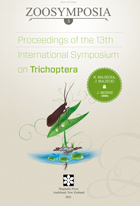Abstract
Ultrastructure of the cells forming the sternal glands in males and both fertilized and virgin females of Phryganea bipunctata Retzius and Phryganea grandis L. has been studied by optical and transmission electron microscopy. The structures involved in the synthesis and excretion of pheromone mixtures consist of 4 types of cells: secretory, canal, muscle and epidermal. The secretory and canal cells form a compound structure where the secretory cells produce the secretion, while the canal cells form the conducting and receiving cuticular canals, which participate in conducting the secretion to the cavity of a cuticular reservoir. The cuticle of the reservoir is rough and has numerous folds. Muscle fibers are situated between the epidermal cells and the secretory cells in several layers, which are perpendicular to each other. The presence of muscle fibers in pheromone glands is in agreement with the eliciting of the droplets from the gland orifice in this family. The structure of muscle fibers changes in inseminated females: they become more loose and apparently non-functional. The ultrastructure of secretory cells of the pheromone glands evidences also the greater functional activity of these glands in females as compared to the cells of males. The presence of muscle fibers in the examined pheromone glands in Trichoptera suggests these structures to be a putative apomorphy of Phryganeidae.

